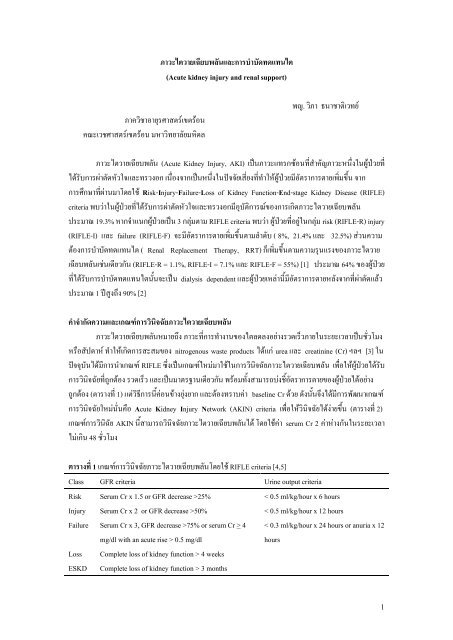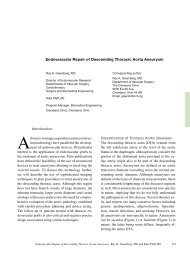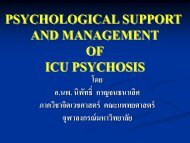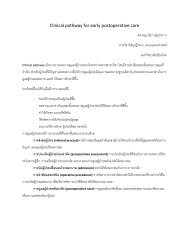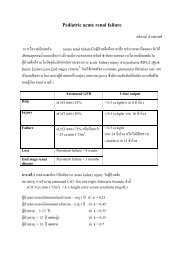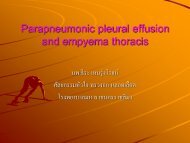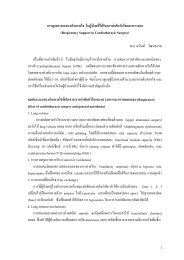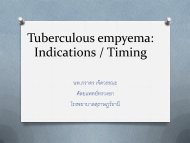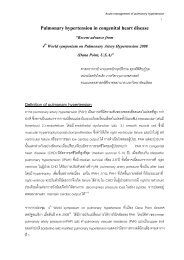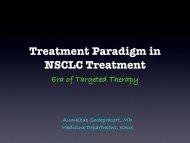Acute kidney injury and renal support
Acute kidney injury and renal support
Acute kidney injury and renal support
Create successful ePaper yourself
Turn your PDF publications into a flip-book with our unique Google optimized e-Paper software.
ตารางที่ 3 กลไกและสาเหตุของภาวะไตวายเฉียบพลันระยะกอนผาตัด ระยะผาตัด ระยะหลังผาตัดIschemic <strong>kidney</strong> <strong>injury</strong>:Renal artery embolismLow cardiac outputNeurohormonal activationIschemic <strong>kidney</strong> <strong>injury</strong>:Embolic eventsHypotensionDecrease of MAPNeurohormonal activationHemodilutionIschemic <strong>kidney</strong> <strong>injury</strong>:Low cardiac output (ตารางที่ 4)Inflammation:Atherosclerotic heart diseaseCongestive heart failureInfectionOxidative stress:-Nephrotoxins:Contrast mediaNSAIDsAntibioticsInflammation:CPB-induced inflammationOxidative stress:Ischemic reperfusion <strong>injury</strong>Nephrotoxins:Free hemoglobinInflammation:InfectionOxidative stress:Ischemic reperfusion <strong>injury</strong>Nephrotoxins:MyoglobinContrast mediaNSAIDsAntibioticsระยะกอนผาตัด (Pre-operative period)กอนที่ผูปวยจะไดรับการผาตัดหัวใจและทรวงอกนั้น สวนใหญมักจะมีปจจัยที่ทําใหไตมีความสามารถในการทํางานลดลงมากกวาคนปกติ ปจจัยเหลานี้ไดแก สูงอายุ (advance age) โรคไตวายเรื้อรัง (chronic <strong>kidney</strong>disease) ซึ่งอาจมีสาเหตุมาจากโรคอื่นๆ ไดแก โรคเบาหวาน โรคความดันโลหิตสูง โรคตับ (hepto<strong>renal</strong>syndrome) หรือ โรคหัวใจ (cardio<strong>renal</strong> syndrome) ฯลฯ [6,7] นอกจากนี้ยังมีภาวะบางภาวะที่อาจเกิดขึ้นพรอมๆกันกอนที่ผูปวยจะไดรับการผาตัดที่ทําใหการทํางานของไตบกพรองเพิ่มมากขึ้น ภาวะเหลานี้ ไดแก1. ภาวะที่เลือดไปเลี้ยงไตลดลง (<strong>renal</strong> hypoperfusion)ภาวะนี้ทําใหเกิด ischemic <strong>kidney</strong> <strong>injury</strong> ซึ่งทําใหเกิด endothelial cell dysfunction เปนผลใหมีการสรางnitric oxide ลดลง และสราง endothelin เพิ่มขึ้น ทําใหเกิด <strong>renal</strong> vasoconstriction เปนผลใหขาดเลือดไปเลี้ยงไตและทําใหเกิด tubular damage ในที่สุด หากภาวะการขาดเลือดไปเลี้ยงไตนั้นไมรุนแรง อาจทําใหเกิดcytoskeleton disruption เทานั้น แตถาหากการขาดเลือดไปเลี้ยงไตนั้นเกิดขึ้นอยางรุนแรงอาจทําใหเกิด apoptoticcell death ได ทั้งภาวะการเกิด <strong>renal</strong> vasoconstriction และ tubular damage นี้ทําให glomerular filtration rate(GFR) ลดลง [3,8]ภาวะที่เลือดไปเลี้ยงไตลดลง (<strong>renal</strong> hypoperfusion) นี้อาจมีสาเหตุมาจากการอุดตันของเสนเลือดที่ไต ที่พบบอย ไดแก <strong>renal</strong> artery embolism หรืออาจเกิดจากภาวะที่ทําให cardiac output (CO) ลดลง เชน ภาวะ3
1.4 การเกิด Neurohormonal activation ในผูปวยที่ไดรับการทํา CPB จะมีระดับ catecholamine(epinephrine และ norepinephrine) และ renin เพิ่มสูงขึ้นในระหวางการผาตัด เปนผลให <strong>renal</strong>blood flow ลดลง เนื่องจากเสนเลือดที่ไตมีการหดตัว (<strong>renal</strong> vasoconstriction) [9]1.5 ภาวะ hemodilution เมื่อผูปวยเกิดสภาวะ hypoperfusion และ hypothermia ในระหวางการผาตัดCPB การทํา hemodilution นั้นมีสวนชวยให blood viscosity ลดลง ทําใหเลือดมีการไหลเวียนดีขึ้น [19] จากการศึกษาพบวาในระหวางที่ผูปวยไดรับการทํา CPB ซึ่งมีระดับความเขมขนของเลือด ( hematocrit) ต่ํากวา 20% อาจเปนปจจัยหนึ่งที่ทําใหเกิดภาวะไตวายเฉียบพลันไดหลังการผาตัด ทั้งนี้เนื่องจากความสามารถในการนํา oxygen ไปที่ไตนอยลง ทําใหเกิด ischemic <strong>injury</strong>ได อยางไรก็ตามการศึกษาเหลานี้ยังมีขอจํากัด เนื่องจากเปนการศึกษาแบบยอนหลัง(retrospective study) หรือ การศึกษาโดยสังเกตุแบบไปขางหนา (prospective observationalstudy) เทานั้น [20,21] ดังนั้นจึงควรมีการศึกษาแบบ r<strong>and</strong>omized controlled trial กอนจึงจะสรุปผลการศึกษาเหลานี้ได2. ภาวะการทํางานของไตบกพรองจาก nephrotoxinsภาวะนี้อาจเกิดจาก endogenous toxin เชน free hemoglobin เปนตน จากการศึกษาของ Loef และคณะฯพบวาผูปวยที่ไดรับการผาตัด CPB จะมีระดับ free hemoglobin เพิ่มขึ้นประมาณ 10 เทาของระดับในคนปกติหลังการผาตัด ปริมาณ free hemoglobin นี้จะเพิ่มมากขึ้นตามระยะเวลาของการทํา CPB [22] นอกจากนี้ยังพบอีกวาระยะเวลาของการทํา CPB นั้นมีผลตอการทํางานของไตอยางมีนัยสําคัญทางสถิติ [18] ดังนั้นอาจเปนไปไดที่ภาวะ pigment nephropathy อาจเปนสาเหตุหนึ่งที่ทําใหเกิดภาวะไตวายเฉียบพลันภายหลังการผาตัดหัวใจและทรวงอก การเกิดภาวะ hemolysis ระหวางการผาตัด CPB นั้นอาจเกิดจาก shear stress บนผิวของเม็ดเลือดแดงที่สัมผัสกับพื้นผิวของเครื่อง CPB pump ที่มีความเร็วและแรงดันสูง ทําใหเม็ดเลือดแดงแตก (hemolysis) [9] ในสภาวะที่รางกายมีความเปนกรด hemoglobin จะเปลี่ยนเปน met- hemoglobin หลังจากนั้น met- hemoglobin จะจับตัวกันที่บริเวณ distal tubule เปนผลใหเกิดการอุดตันของทอไตในที่สุด [23] นอกจากนี้ยาที่ใชในระหวางการผาตัดซึ่งมีฤทธิ์เปน anti-fibrinolytic agents เชน aprotinin, tranexamic acid และ protamine พบวายาเหลานี้ไมมีผลเสียตอการทํางานของไต [24-26]3. ภาวะการอักเสบ (inflammation)ภาวะการอักเสบที่เกิดขึ้นในระหวางการผาตัด อาจเกิดขึ้นในกระบวนการผาตัด หรืออาจเกิดจากการที่เลือดสัมผัสกับเครื่อง CPB pump ทําใหรางกายรับรูวาเปนสิ่งแปลกปลอม ซึ่งจะกระตุนใหมีการหลั่ง mediatorsตางๆ (รูปที่ 1) และเกิดภาวะไตวายเฉียบพลันในที่สุด [19]6
รูปที่ 1 กลไกการเกิดภาวะอักเสบ (inflammation) ใน CPB [19]จากการศึกษาในระยะเวลามากกวา 20 ป พบวาภาวะแทรกซอนที่เกิดขึ้นหลังจากผูปวยไดรับการผาตัดหัวใจและทรวงอกนั้นมีความสัมพันธกับภาวะการอักเสบ (inflammation) ที่เกิดขึ้นในรางกายของผูปวย [27,28]แตภาวะการอักเสบ (inflammation) นั้นจะสัมพันธกับการเกิดภาวะไตวายเฉียบพลันหรือไมยังไมทราบแนชัด จากการศึกษาของ Rinder และคณะฯ พบวาผูปวยที่เกิดภาวะไตวายเฉียบพลันหลังจากการผาตัด CPB นั้น จะมีปริมาณneutrophil และ neutrophil CD11b ซึ่งเปน neutrophil adhesion receptor เพิ่มสูงกวาผูปวยที่ไมเกิดภาวะไตวายเฉียบพลันอยางมีนัยสําคัญทางสถิติ [29] สําหรับผูปวยที่ไดรับการทํา leukocyte depletion กอนทําการผาตัด CPBนั้น พบวา markers ของ tubular และ glomerular <strong>injury</strong> จะลดต่ําลง [30]4. ภาวะ oxidative stressจากการศึกษาพบวาในระหวางการผาตัด ผูปวยที่ไดรับการทํา CPB จะมี lipid peroxidation เพิ่มขึ้น และมี antioxidant ในเลือดลดลง [31] ดังนั้นภาวะ oxidative stress อาจเปนกลไกหนึ่งที่ทําใหเกิดภาวะไตวายเฉียบพลัน อยางไรก็ตามยังไมมีขอมูลเพียงพอที่จะสรุปผลไดผูปวยที่มีภาวะหัวใจขาดเลือดอาจจะเกิด reperfusion <strong>injury</strong> ไดหลังจากที่ไดรับการผาตัด CPB การที่เกิดreperfusion นี้จะทําใหรางกายสราง oxygen-derived free radicals ที่เกิดจากการปลดปลอยของ iron ที่อยูใน freehemoglobin เมื่อ iron เหลานี้ผานขบวนการ Haber-Weiss reaction ผลที่ไดจะมี hydroxyl radical เกิดขึ้น ซึ่งตอมาจะทําใหเกิด lipid peroxidation ขึ้น ขบวนการนี้เรียกวา oxidative stress ขบวนการนี้สามารถทําใหเกิด cell <strong>injury</strong>ได [32] นอกจากนี้ภาวะน้ําตาลในเลือดสูง (hyperglycemia) อาจเปนสาเหตุหนึ่งที่ทําใหเกิด oxidative <strong>injury</strong> ที่ไต7
เนื่องจากมีระดับ peroxynitrite เพิ่มขึ้น และ peroxynitrite ที่เพิ่มขึ้นนี้มีผลทําใหเกิด cell <strong>injury</strong> ไดเชนเดียวกัน[33]ระยะหลังผาตัด (Post-operative period)ปญหาที่สําคัญของผูปวยในระยะหลังการผาตัดหัวใจและทรวงอกนั้นมักเกิดจากสาเหตุตางๆ ที่ทําใหCO ลดลง (ตารางที่ 4)ตารางที่ 4 สาเหตุของ cardiac output ลดลงหลังการผาตัด [7]Inadequate preload- Volume deficit- Excessive positive end-expiratory pressureIncreased afterload- Vasoconstriction from endogenous catecholamines(sympathetic stimulation)Painful stimuliNonpulsatile flow during CPBHypothermiaPreexisting hypertension- Vasoconstriction from exogenous catecholamines(sympathetic stimulation)- Aortic stenosis- Idiopathic hypertrophic subaortic stenosisMetabolic derangement- Hypocalcemia- Hypomagnesemia- Hypoxia- AcidosisSepticemiaMyocardial depression- Uncorrected mechanical lesionsIncomplete coronary revascularizationValvalar stenosis or insufficiencyMechanical valve malfunction- Functional depression (lasts ~ 24 h)- Coronary spasm- Inadequate myocardial protection intraoperativelyMyocardial edemaMyocardial ischemiaMyocardial necrosis-infarctPharmacologic depression- Anesthetic agents- Quinidine- Procainamide- Lidocaine- Beta-blockers- Calcium channel blockersArrhythmiasTamponade8
การลดลงของ CO นี้อาจเปนสาเหตุหนึ่งที่ทําใหการทํางานของรางกายในระบบตางๆลมเหลว ไดแก ระบบประสาท ระบบทางเดินหายใจ ระบบไต และระบบทางเดินอาหาร [7] ดังนั้นการเกิดภาวะไตวายเฉียบพลันหลังการผาตัดอาจเกิดจากภาวะตางๆ ดังนี้1. ภาวะที่เลือดไปเลี้ยงไตลดลง (<strong>renal</strong> hypoperfusion)ภาวะนี้มักเกิดจากการที่ CO ลดลงจากสาเหตุตางๆ ดังแสดงในตารางที่ 4 นอกจากนี้ระยะหลังผาตัดระบบ neurohormonal system ยังคงถูกกระตุน ทําใหผูปวยเกิดภาวะการขาดเลือดไปเลี้ยงที่ไตเพิ่มขึ้น [9]2. ภาวะการทํางานของไตบกพรองจาก nephrotoxinsภาวะนี้มักเกิดจากยาที่ผูปวยไดรับหลังการผาตัด เชน ยาแกปวดกลุม NSAIDs ยาปฏิชีวนะกลุมaminoglycoside สารทึบแสง (contrast media) เปนตน ยาเหลานี้อาจทําใหเกิดภาวะไตวายเฉียบพลันไดตามกลไกที่กลาวมาแลวขางตน สวน endogenous toxin ที่อาจเกิดขึ้นหลังการผาตัด ไดแก myoglobinจากภาวะ rhabdomyolysis [34,35] ซึ่งสามารถทําใหเกิดภาวะไตวายเฉียบพลันไดหลังการผาตัดโดยผานทางกลไกที่คลายคลึงกับกลไกของภาวะ hemolysis ที่ทําใหเกิดภาวะไตวายเฉียบพลัน ทั้งนี้เนื่องจากhemoglobin และ myoglobin มีลักษณะโครงสรางทางเคมีคลายคลึงกัน นั่นคือ hemoglobinประกอบดวย heme protein 4 ตัว ซึ่งมี iron (Fe 2+ ) อยูในสวนกลางของโปรตีนแตละตัว สวน myoglobinประกอบดวย heme protein เพียง 1 ตัว ดังนั้นจึงมี iron (Fe 2+ ) เพียง 1 ตัวเทานั้น [23]3. ภาวะการอักเสบ (Inflammation)ภาวะนี้สวนใหญเกิดจากการติดเชื้อหลังผาตัด ซึ่งจะกระตุนใหมีการหลั่ง cytokines และchemokines ตางๆ เปนผลใหเกิดการหดตัวของเสนเลือดที่ไต (<strong>renal</strong> vasoconstriction) [13] นอกจากนี้ภาวะการติดเชื้อยังทําใหเกิด cytolysis โดยผานทาง complement system ได [16]4. ภาวะ oxidative stressภาวะนี้เกิดจาก ischemic reperfusion <strong>injury</strong> ที่อาจเกิดขึ้นที่ไตหรือที่อวัยวะอื่นๆ ซึ่งมีผลใหเกิด cell<strong>injury</strong> ที่ไต [9] นอกจากนี้ภาวะน้ําตาลในเลือดสูง ( hyperglycemia) ยังทําใหเกิดภาวะ oxidative <strong>injury</strong>ไดเชนเดียวกัน [33]การปองกันและรักษาผูปวยที่มีภาวะไตวายเฉียบพลันผูปวยที่มีภาวะไตวายเฉียบพลันรวมดวยหลังจากไดรับการผาตัดหัวใจและทรวงอกนั้น จะมีอัตราการตายเพิ่มมากขึ้น โดยเฉพาะอยางยิ่งในผูปวยที่เปน dialysis dependent หลังจากเกิดภาวะไตวายเฉียบพลัน ดังนั้นสิ่งที่สําคัญที่สุดประการหนึ่งในการดูแลรักษาผูปวยที่ไดรับการผาตัดหัวใจและทรวงอก คือการปองกันการเกิดภาวะไตวายเฉียบพลัน ทั้งนี้เพื่อลดอัตราการตายในผูปวยเหลานี้จากกลไกหลัก 4 กลไกของการเกิดภาวะไตวายเฉียบพลันในผูปวยที่ไดรับการผาตัดหัวใจและทรวงอกนั้น ประกอบดวย ischemic <strong>kidney</strong> <strong>injury</strong>, inflammation, oxidative stress และ nephrotoxins ดังนั้นเพื่อเปนการ9
ปองกันหรือรักษาภาวะไตวายเฉียบพลัน อาจกระทําไดโดยการเพิ่ม <strong>renal</strong> blood flow (RBF) หรือลดการหดตัวของเสนเลือดที่ไต (<strong>renal</strong> vasoconstriction) นอกจากนี้การปองกันหรือยับยั้งการเกิดภาวะ inflammation และoxidative stress หรือการหลีกเลี่ยงยาที่มีผลตอไต ก็เปนสวนหนึ่งในการปองกันและรักษาภาวะไตวายเฉียบพลันดวยเชนกันการปองกันและรักษาการเกิดภาวะไตวายเฉียบพลันในผูปวยที่ไดรับการผาตัดหัวใจและทรวงอกสามารถแบงไดเปน 2 ประเภทดังนี้1. Pharmacological interventionsเปนการปองกันและรักษาการเกิดภาวะไตวายเฉียบพลันโดยการใชยา ซึ่งสามารถแบงยาไดเปน 3 กลุมนั่นคือ กลุมยาที่ใชเพื่อเพิ่ม RBF กลุมยาที่ใชเพื่อลดภาวะ inflammation และกลุมยาที่ใชเพื่อลดภาวะ oxidativestressยาในกลุมที่ใชเพื่อเพิ่ม RBF ไดแก dopamine [36-39], fenoldapam [40-43], natriuretic peptides (ANP,BNP) [44-48] และ diltiazem [49] สําหรับการใชยา furosemide [50,51] หรือ mannitol [52-54] นั้น มีจุดมุงหมายเพื่อใหมีปริมาณปสสาวะออกเพิ่มมากขึ้น พรอมทั้งชวยลดการเกิด tubular obstruction สวนการใชยาdexamethazone [55] เพื่อลดภาวะ inflammation หรือการใชยา N-acetylcysteine (NAC) [42,56] เพื่อลดภาวะoxidative stress นั้น พบวายังไมมีขอมูลที่จะยืนยันไดวายาในกลุมเหลานี้สามารถใชเปนยาปองกันหรือรักษาการเกิดภาวะไตวายเฉียบพลันหลังการผาตัดได สวนยา furosemide ที่ใหในรูปแบบ continuous infusion หรือdopamine ที่ใหเพื่อการรักษาผูปวยที่มีภาวะไตวายเฉียบพลัน พบวาผูปวยที่ไดรับยาเหลานี้ทําใหการทํางานของไตลดลงมากขึ้น [46,51]2. Non- pharmacological interventionsเปนการปองกันและรักษาการเกิดภาวะไตวายเฉียบพลันโดยไมเกี่ยวของกับการใชยา ซึ่งสามารถแบงไดเปน 4 ประเภท ไดแกประเภทที่ 1 การเพิ่ม RBF โดยวิธี preoperative hydration จากการศึกษาพบวาวิธีนี้สามารถลดอัตราการเกิดภาวะไตวายเฉียบพลันได [57] แตอยางไรก็ตามการใหสารน้ําแกผูปวยควรใหดวยความระมัดระวัง เนื่องจากผูปวยที่ไดรับการผาตัดหัวใจและทรวงอกที่มีภาวะ positive fluid balance เกิดขึ้นในระหวางการผาตัด อาจจะมีอัตราการตายเพิ่มมากขึ้น [58,59] ดังนั้นจึงควรใชวิธีของ goal-directed therapy เพื่อเปนแนวทางสําหรับการใหสารน้ํา [ ุ60,61] สวนการใช pulsatile CPB flow [62,63] หรือการใช ‘no-touch’ technique สําหรับ aorticmanipulation [64] หรือการที่ความเขมขนเลือด (hematocrit) มากกวา 20% ระหวางที่ผูปวยอยูในเครื่อง CPBpump [20,21] นั้น ยังไมขอมูลเพียงพอที่จะยืนยันไดวาวิธีการเหลานี้สามารถปองกันการเกิดภาวะไตวายเฉียบพลันไดประเภทที่ 2 การลดภาวะ inflammation โดยใช on- หรือ off-pump surgery พบวาอุบัติการณของการเกิดภาวะไตวายเฉียบพลันนั้นไมตางกัน [ ุ65,66] แตการใช off-pump surgery อาจทําใหมี MAP ต่ํากวาการใช onpumpsurgery ซึ่งอาจเปนผลใหเกิดภาวะไตวายเฉียบพลันเพิ่มขึ้นได [22]ประเภทที่ 3 การลดภาวะ oxidative stress โดยการควบคุมระดับน้ําตาลในเลือดใหอยูในเกณฑปกติหลังการผาตัด พบวาสามารถลดอัตราการเกิดภาวะไตวายเฉียบพลันและลดการบําบัดทดแทนไตไดมากถึง 40% [ ุ10
67,68] แตการควบคุมระดับน้ําตาลในเลือดใหอยูในเกณฑปกติระหวางการผาตัดหัวใจและทรวงอกนั้น พบวายังไมสามารถปองกันภาวะไตวายเฉียบพลันหลังการผาตัดได [69]ประเภทที่ 4 การหลีกเลี่ยงการใชยาหรือสารที่มีผลตอไต ไดแก ยาแกปวดกลุม NSAIDs สารทึบแสง(contrast media) ฯลฯ จะสามารถปองกันภาวะไตวายเฉียบพลันหลังการผาตัดได นอกจากนี้ยังพบอีกวาผูปวยที่ไดรับยาลดความดันโลหิตสูงในกลุม ACEI โดยเฉพาะอยางยิ่งยา ARB เปนระยะเวลามากกวา 5 วันกอนไดรับการผาตัดหัวใจและทรวงอก มักจะมีภาวะความดันโลหิตต่ําและตองใชยากลุม vasopressor ในระหวางการผาตัดและหลังการผาตัดมากกวาผูปวยที่ไมไดรับยาเหลานี้อยางมีนัยสําคัญทางสถิติ [70,71] แตการหยุดยาเหลานี้กอนการผาตัด 1 วัน จะชวยลดการเกิดภาวะความดันโลหิตต่ําในระหวางการผาตัดและหลังการผาตัดได [72] หลังจากนั้นสามารถเริ่มยาเหลานี้ไดอีกในวันที่ 2 หลังการผาตัด โดยที่ผูปวยจะตองหยุดใชเครื่อง IABP หรือหยุดการใชยาvasopressor แลว ขอดีของการใชยากลุม ACEI นี้ คือชวยใหการทํางานของไตดีขึ้นภายหลังการผาตัดนอกเหนือจากประโยชนตอหัวใจและหลอดเลือด [73]นอกจากนี้ การใช preoperative ‘prophylactic’ RRT เพื่อควบคุมระดับน้ําในรางกายและระดับของเสียตางๆที่เกิดขึ้นในรางกายที่มีผลตอการทํางานของหัวใจ เพื่อปองกันภาวะไตวายเฉียบพลันและเพื่อลดอัตราการตายของผูปวยเหลานี้ พบวาในผูปวยที่มีคา serum Cr มากกวา 2.5 มก./ดล. และไดรับการบําบัดทดแทนไตกอนการผาตัดหัวใจ จะมีอัตราการตายนอยกวาผูปวยที่ไมไดรับการบําบัดทดแทนไตอยางมีนัยสําคัญทางสถิติ แตการประเมินวาวิธีการนี้สามารถใชเพื่อลดอัตราการเกิดภาวะไตวายเฉียบพลันนั้นไมสามารถกระทําได เนื่องจากผูปวยที่ไดรับการบําบัดทดแทนไตระหวางการผาตัดยอมตองมีคา serum Cr หลังการผาตัดที่ต่ํากวาผูปวยที่ไมไดรับการบําบัดทดแทนไต [74,75]ดังนั้น การปองกันและรักษาภาวะไตวายเฉียบพลันในผูปวยที่ไดรับการผาตัดหัวใจและทรวงอกนั้น สิ่งที่สําคัญที่สุดคือ การควบคุมระดับน้ําในรางกายใหอยูในเกณฑปกติ (euvolemic status) การหลีกเลี่ยงการใชยาหรือสารที่มีผลตอไต การควบคุมระดับน้ําตาลในเลือดใหอยูในเกณฑปกติ และการรักษาภาวะอื่นๆที่อาจทําใหCO ลดลงหลังการผาตัด [7]การบําบัดทดแทนไตในผูปวยที่มีภาวะไตวายเฉียบพลันหลังการผาตัดหัวใจและทรวงอกการบําบัดทดแทนไตในผูปวยที่มีภาวะไตวายเฉียบพลันมีวัตถุประสงค เพื่อปองกันการเกิดภาวะแทรกซอนในระหวางที่รอไตฟนตัวในการทํางาน (recovery of <strong>renal</strong> function) โดยปกติผูปวยจะไดรับการบําบัดทดแทนไต ตอเมื่อมีขอบงชี้ตางๆ ไดแก ภาวะน้ําเกินในรางกาย ภาวะโปแตสเซียม (potassium, K) ในเลือดสูง ภาวะ metabolic acidosis และภาวะ uremia [3] อยางไรก็ตามในกรณีที่ผูปวยมีคา blood urea nitrogen (BUN)มากกวา 80 มก. /ดล. แตยังไมมีขอบงชี้อื่นๆดังที่ไดกลาวมาแลว ผูปวยอาจไดรับการบําบัดทดแทนไตไดเชนเดียวกัน จากการศึกษาแบบ clinical trial และ historical control ของ Demirkilic และคณะฯ พบวาผูปวยที่มีภาวะไตวายเฉียบพลันหลังผาตัดหัวใจและทรวงอก ซึ่งไดรับการบําบัดทดแทนไตเมื่อมีปริมาณปสสาวะออกนอยกวา 100 มล. ในระยะเวลา 8 ชั่วโมง แมวาผูปวยจะไดรับยา furosemide แลวก็ตาม ผูปวยเหลานี้จะมีอัตราการตาย(23.5%) นอยกวาผูปวยที่ไดรับการบําบัดทดแทนไต เมื่อมีระดับ serum Cr มากกวา 5 มก. /ดล. หรือมีคา serum Kมากกวา 5.5 mEq/L (55.5%) อยางมีนัยสําคัญทางสถิติ [76] ผลการศึกษานี้คลายคลึงกับผลการศึกษาของ Elahiและคณะฯ ซี่งทําการศึกษายอนหลังแบบ retrospective cohort study พบวาผูปวยที่มีภาวะไตวายเฉียบพลันเกิดขึ้นหลังการผาตัดหัวใจ และไดรับการบําบัดทดแทนไตเมื่อมีปริมาณปสสาวะออกนอยกวา 100 มล. ในระยะเวลา 811
ชั่วโมง จะมีอัตราการตาย (22 %) นอยกวาผูปวยที่ไดรับการบําบัดทดแทนไตเมื่อมีคา BUN มากกวา 84 มก./ดล.หรือมีคา serum Cr มากกวา 2.8 มก. /ดล. หรือมีคา serum K มากกวา 6 mEq/L (43%) อยางมีนัยสําคัญทางสถิติ[77] อยางไรก็ตามไมมีรายงานของคา serum Cr และคา BUN กอนที่จะไดรับการบําบัดทดแทนไตในกลุมผูปวยที่มีปริมาณปสสาวะออกนอยกวา 100 มล. ในระยะเวลา 8 ชั่วโมงในการศึกษาทั้งสองที่ไดรายงานมานี้ นอกจากนี้ในผูปวยกลุมที่มีปริมาณปสสาวะออกนอยกวา 100 มล. เปนระยะเวลา 8 ชั่วโมง โดยไมไดรับการบําบัดทดแทนไตนั้น ยังไมรายงานเกี่ยวกับอัตราการตายในผูปวยกลุมนี้ และไมทราบวาการทํางานของไตกลับมาเปนปกติหรือไม ดังนั้นจึงควรศึกษาเพิ่มเติมเพื่อยืนยันผลการศึกษาเหลานี้จากการศึกษาไปขางหนาแบบ prospective r<strong>and</strong>omized controlled trial ในผูปวยภาวะวิกฤตที่มีภาวะไตวายเฉียบพลัน พบวาผูปวยที่ไดรับการทํา early dialysis เนื่องจากมีปริมาณปสสาวะออกนอยกวา 30 มล./ชม. เปนเวลานานมากกวา 6 ชั่วโมง และมีคา CrCl นอยกวา 20 มล./นาที มีอัตราการตายไมตางจากผูปวยที่ไดรับการบําบัดทดแทนไต เมื่อมีขอบงชี้ตาง ๆ ไดแก คา BUN มากกวา 112 มก./ดล. หรือคา serum K มากกวา 6.5 mEq/L หรือการที่ผูปวยมีภาวะน้ําเกิน ฯลฯ ดังที่ไดกลาวมาแลวขางตน [78]ดังนั้นจึงยังไมสามารถที่จะสรุปไดวา ระยะเวลาที่เหมาะสมของการบําบัดทดแทนไตในผูปวยที่ไดรับการผาตัดหัวใจและทรวงอกที่มีภาวะไตวายเฉียบพลันนั้น ควรจะกระทําเมื่อใดจึงจะไดผลดีมากที่สุด แตจากการศึกษาตาง ๆ ที่ไดกลาวมานี้จะเห็นไดวายังสามารถใชขอบงชี้ตาง ๆ ดังที่กลาวมาแลวขางตนในการบําบัดทดแทนไตในผูปวยภาวะไตวายเฉียบพลันไดวิธีบําบัดทดแทนไตในผูปวยภาวะไตวายเฉียบพลัน (Modality of RRT in AKI)โดยทั่วไปวิธีการบําบัดทดแทนไตในผูปวยที่มีภาวะไตวายเฉียบพลัน มีวิธีตาง ๆ ดังนี้1. Peritoneal dialysis (PD)วิธีนี้เปนวิธีที่นิยมใชนอยที่สุด (
การทํางานของไต (recovery of <strong>renal</strong> function) ไมตางจากผูปวยที่ไดรับการบําบัดทดแทนไตดวยวิธี CRRTซึ่งจะกลาวตอไป วิธีการเหลานี้ ไดแก CVVH [82] CVVHD [83] และ CVVHDF [84-86]3. Continuous <strong>renal</strong> replacement therapy (CRRT)เปนวิธีที่นิยมใชมากที่สุดในผูปวยที่อยูในภาวะวิกฤต โดยมีการใชวิธีนี้สูงถึง 80% วิธีนี้เปนวิธีที่ทําใหมีภาวะ hemodynamic stability ที่ดีกวาและสามารถควบคุมระดับน้ําในรางกายไดดีเชนกัน จากการศึกษาพบวาผูปวยหลังการผาตัดหัวใจที่มีภาวะไตวายเฉียบพลันและใชวิธี CRRT เปนวิธีการบําบัดทดแทนไต มีอัตราการตายประมาณ 40% ตอมาไดมีการพัฒนาเครื่อง CRRT ใหสามารถใชงานไดงายขึ้นพรอมทั้งไดมีการปรับปรุงวิธีการใหมเพื่อใหมีประสิทธิภาพในการขจัดของเสียออกไดมากขึ้น แตวิธีการนี้ก็ยังไมสามารถลดอัตราการตายของผูปวยลงได [87,88] วิธีการบําบัดทดแทนไตดวยวิธี CRRT มีวิธีการดังนี้3.1. Continuous hemofiltration วิธีนี้สามารถขจัดของเสียโดยใชวิธีการ convection3.2. Continuous hemodialysis วิธีนี้สามารถขจัดของเสียโดยใชวิธีการ diffusion3.3. Continuous hemodiafiltration วิธีนี้สามารถขจัดของเสียโดยใชวิธีการ diffusion และ convection4. Hybrid therapyวิธีนี้เปนวิธีการบําบัดทดแทนไต ที่นําวิธีการตาง ๆ มาผสมผสานกันโดยการนําวิธี hemodialysis ที่มีความงายและวิธี CRRT ที่มีขอดีตาง ๆ ที่กลาวมาแลวมาใชรวมกัน โดยการเพิ่มระยะเวลาของการบําบัดทดแทนไตและลด blood flow ลงการบําบัดทดแทนไตโดยวิธี hybrid therapy มีวิธีการตางๆ ดังนี้4.1. Extended daily dialysis (EDD)4.2. Sustained low-efficiency dialysis (SLED)4.3. Sustained low-efficiency daily diafiltration (SLED-f)จากการศึกษาในผูปวยภาวะวิกฤตที่ไดรับการบําบัดทดแทนไตโดยวิธี EDD นั้น พบวาคาhemodynamic ตางๆ ในผูปวยจะมีการเปลี่ยนแปลง เชน อัตราการเตนของหัวใจ (heart rate) systemicvascular resistance คา MAP และ CO เปนตน แตการเปลี่ยนแปลงของคา hemodynamic ที่เกิดจากการใชวิธี EDD นี้ไมแตกตางจากการใชวิธี CVVH ในการบําบัดทดแทนไต นอกจากนี้ยังพบวาผูปวยที่ไดรับการบําบัดทดแทนไตโดยวิธี EDD นี้จะใช heparin ในปริมาณที่นอยกวาผูปวยที่ไดรับการบําบัดทดแทนไตดวยวิธี CVVH อยางมีนัยสําคัญทางสถิติ [89]สรุป จากการศึกษาตาง ๆ เกี่ยวกับวิธีการบําบัดทดแทนไตที่ใชในผูปวยที่ไดรับการผาตัดหัวใจและทรวงอกที่มีภาวะไตวายเฉียบพลันนั้น ยังไมสามารถที่จะสรุปไดวาวิธีการใดเปนวิธีที่ดีที่สุดหรือเหมาะสมที่สุด อยางไรก็ตามจากการศึกษาผูปวยที่อยูในภาวะวิกฤตนั้น พบวาการบําบัดทดแทนไตดวยวิธีการตางกันจะมีอัตราการตายไมตางกัน ดังนั้นการเลือกใชวิธีการบําบัดทดแทนไตวิธีใดนั้น ควรพิจารณาตามความเหมาะสม ทั้งสภาวะของผูปวย ประสบการณและความชํานาญของบุคคลากรทางการแพทย ตลอดจนเครื่องมือและอุปกรณตางๆ ที่มีอยูในแตละโรงพยาบาลหรือสถาบัน เพื่อใหดูแลรักษาผูปวยภาวะไตวายเฉียบพลันไดอยางมีประสิทธิภาพสูงสุด13
บรรณานุกรม1. Kuitunen A, Vento A, Suojaranta-Ylinen R, Pettilä V. <strong>Acute</strong> <strong>renal</strong> failure after cardiac surgery:evaluation of the RIFLE classification. Ann Thorac Surg. 2006;81:542-6.2. Mangano CM, Diamondstone LS, Ramsay JG, Aggarwal A, Herskowitz A, Mangano DT. Renaldysfunction after myocardial revascularization: risk factors, adverse outcomes, <strong>and</strong> hospital resourceutilization. The Multicenter Study of Perioperative Ischemia Research Group. Ann Intern Med.1998;128:194-203.3. Brady HR, Clarkson MR, Lieberthal W. <strong>Acute</strong> <strong>renal</strong> failure. In: Brenner & Rector’s The Kidney,edited by Brenner BM, Philadelphia, Saunders, 2004:1215-92.4. Lopes JA, Fern<strong>and</strong>es P, Jorge S, et al.<strong>Acute</strong> <strong>kidney</strong> <strong>injury</strong> in intensive care unit patients: acomparison between the RIFLE <strong>and</strong> the <strong>Acute</strong> Kidney Injury Network classifications. Crit Care.2008;12:R110.5. Bagshaw SM, George C, Bellomo R; ANZICS Database Management Committe. A comparison ofthe RIFLE <strong>and</strong> AKIN criteria for acute <strong>kidney</strong> <strong>injury</strong> in critically ill patients. Nephrol Dial Transplant.2008;23:1569-74.6. Lee HT, Sladen RN. Perioperative <strong>renal</strong> protection. In: Critical Care Medicine: PerioperativeManagement, edited by Murray MJ, Coursin DB, Pearl RG, Prough DS, Philadelphia, LippincottWilliams & Wilkins, 2002: 503-20.7. Dudick C, Lisbon A. Management of postoperative cardiac surgical patient. In: Irwin <strong>and</strong> Rippe'sIntensive Care Medicine, edited by Irwin RS, Rippe JM, Philadelphia, Lippincott Williams &Wilkins, 2008:1740-54.8. Abuelo JG. Normotensive ischemic acute <strong>renal</strong> failure. N Engl J Med. 2007;357:797-805.9. Bellomo R, Auriemma S, Fabbri A, et al. The pathophysiology of cardiac surgery-associated acute<strong>kidney</strong> <strong>injury</strong> (CSA-AKI). Int J Artif Organs 2008;31:166-78.10. Rose BD, Post WT. Renal circulation <strong>and</strong> glomerular filtration rate. In: Clinical Physiology of Acid-Base <strong>and</strong> Electrolyte Disorders, edited by Rose BD, Singapore, McGraw-Hill, 2001: 21-70.11. Schetz M, Dasta J, Goldstein S, Golper T. Drug-induced acute <strong>kidney</strong> <strong>injury</strong>. Curr Opin Crit Care.2005;11:555-65.12. Brezis M, Rosen S. Hypoxia of the <strong>renal</strong> medulla--its implications for disease. N Engl J Med.1995;332:647-55.13. Schor N. <strong>Acute</strong> <strong>renal</strong> failure <strong>and</strong> the sepsis syndrome. Kidney Int. 2002;61:764-76.14. Levine B, Kalman J, Mayer L, Fillit HM, Packer M. Elevated circulating levels of tumor necrosisfactor in severe chronic heart failure. N Engl J Med. 1990;323:236–41.14
15. Torre-Amione G, Kapadia S, Benedict C, Oral H, Young JB, Mann DL. Proinflammatory cytokinelevels in patients with depressed left ventricular ejection fraction: A report from the studies of leftventricular dysfunction (SOLVD). J Am Coll Cardiol. 1996;27:1201–6.16. Feehally J, Floege J, Savill J, Turner AN. Glomerular <strong>injury</strong> <strong>and</strong> glomerular response. In: Oxford textbook of clinical nephrology, edited by Davison A, Cameron J S, Grunfeld JP, Ponticelli C, RitzE, Winearls CG, Ypersele CV, New York, Oxford University Press, 2005:363-88.17. Urzua J, Troncoso S, Bugedo G, et al. Renal function <strong>and</strong> cardiopulmonary bypass: effect ofperfusion pressure. 0J Cardiothorac Vasc Anesth. 1992;6:299-303.18. Fischer UM, Weissenberger WK, Warters RD, Geissler HJ, Allen SJ, Mehlhorn U. Impact ofcardiopulmonary bypass management on postcardiac surgery <strong>renal</strong> function. 0Perfusion. 2002;17:401-6.19. Rosner MH, Portilla D, Okusa MD. Analytic reviews: cardiac surgery as a cause of acute <strong>kidney</strong><strong>injury</strong>: pathogenesis <strong>and</strong> potential therapies. J Intensive Care Med 2008;23:3-18.20. Habib RH, Zacharias A, Schwann TA, Riordan CJ, Engoren M, Durham SJ, Shah A. Role ofhemodilutional anemia <strong>and</strong> transfusion during cardiopulmonary bypass in <strong>renal</strong> <strong>injury</strong> after coronaryrevascularization: Implications on operative outcome. Crit Care Med. 2005;33:1749-56.21. Karkouti K, Beattie WS, Wijeysundera DN, et al. Hemodilution during cardiopulmonary bypass is anindependent risk factor for acute <strong>renal</strong> failure in adult cardiac surgery. J Thorac Cardiovasc Surg2005;129:391-400.22. Loef BG, Epema AH, Navis G, Ebels T, van Oeveren W, Henning RH. Off-pump coronaryrevascularization attenuates transient <strong>renal</strong> damage compared with on-pump coronaryrevascularization. Chest. 2002;121:1190-4.23. Haase M, Haase-Fielitz A, Bagshaw SM, Ronco C, Bellomo R. Cardiopulmonary bypass-associatedacute <strong>kidney</strong> <strong>injury</strong>: a pigment nephropathy? Contrib Nephrol. 2007;156:340-53.24. Mangano DT, Tudor IC, Dietzel C; Multicenter Study of Perioperative Ischemia Research Group;Ischemia Research <strong>and</strong> Education Foundation. The risk associated with aprotinin in cardiac surgery. NEngl J Med. 2006;354:353-65.25. Henry DA, Carless PA, Moxey AJ, et al. Anti-fibrinolytic use for minimising perioperative allogeneicblood transfusion. Cochrane Database Syst Rev. 2007;(4):CD001886.26. Mouton R, Finch D, Davies I, Binks A, Zacharowski K. Effect of aprotinin on <strong>renal</strong> dysfunction inpatients undergoing on-pump <strong>and</strong> off-pump cardiac surgery: a retrospective observationalstudy. Lancet. 2008;371:475-82.27. Amar D, Zhang H, Park B, Heerdt PM, Fleisher M, Thaler HT. Inflammation <strong>and</strong> outcome aftergeneral thoracic surgery. 0Eur J Cardiothorac Surg. 2007;32:431-4.15
28. Ucar HI, Tok M, Atalar E, et al. Predictive significance of plasma levels of interleukin-6 <strong>and</strong> highsensitivityC-reactive protein in atrial fibrillation after coronary artery bypass surgery. Heart SurgForum. 2007;10:E131-5.29. Rinder CS, Fontes M, Mathew JP, Rinder HM, Smith BR; Multicenter Study of PerioperativeIschemia Research Group. Neutrophil CD11b upregulation during cardiopulmonary bypass isassociated with postoperative <strong>renal</strong> <strong>injury</strong>. Ann Thorac Surg. 2003;75:899-905.30. Tang AT, Alexiou C, Hsu J, Sheppard SV, Haw MP, Ohri SK. Leukodepletion reduces <strong>renal</strong> <strong>injury</strong> incoronary revascularization: a prospective r<strong>and</strong>omized study. 0Ann Thorac Surg. 2002;74:372-7.31. McColl AJ, Keeble T, Hadjinikolaou L, Cohen A, Aitkenhead H, Glenville B, Richmond W. Plasmaantioxidants: evidence for a protective role against reactive oxygen species following cardiacsurgery. Ann Clin Biochem. 1998;35:616-23.32. Das DK, Engelman RM, Liu X, et al. Oxygen-derived free radicals <strong>and</strong> hemolysis during open heartsurgery. Mol Cell Biochem. 1992;111:77-86.33. Allen DA, Harwood S, Varagunam M, Raftery MJ, Yaqoob MM. High glucose-induced oxidativestress causes apoptosis in proximal tubular epithelial cells <strong>and</strong> is mediated by multiplecaspases. FASEB J. 2003;17:908-10.34. Maccario M, Fumagalli C, Dottori V, et al. The association between rhabdomyolysis <strong>and</strong> acute <strong>renal</strong>failure in patients undergoing cardiopulmonary bypass. J Cardiovasc Surg (Torino). 1996;37:153-9.35. Miller CC 3rd, Villa MA, Sutton J, et al. Serum myoglobin <strong>and</strong> <strong>renal</strong> morbidity <strong>and</strong> mortalityfollowing thoracic <strong>and</strong> thoraco-abdominal aortic repair: does rhabdomyolysis play a role? Eur J VascEndovasc Surg. 2009;37:388-94.36. Kellum JA, M Decker J. Use of dopamine in acute <strong>renal</strong> failure: a meta-analysis. Crit Care Med.2001;29:1526-31.37. Woo EB, Tang AT, el-Gamel A, et al. Dopamine therapy for patients at risk of <strong>renal</strong> dysfunctionfollowing cardiac surgery: science or fiction? Eur J Cardiothorac Surg. 2002;22:106-11.38. Gatot I, Abramov D, Tsodikov V, et al. Should we give prophylactic <strong>renal</strong>-dose dopamine aftercoronary artery bypass surgery? J Card Surg. 2004;19:128-33.39. Lauschke A, Teichgräber UK, Frei U, Eckardt KU. 'Low-dose' dopamine worsens <strong>renal</strong> perfusion inpatients with acute <strong>renal</strong> failure. Kidney Int. 2006;69:1669-74.40. Bove T, L<strong>and</strong>oni G, Calabrò MG, et al. Renoprotective action of fenoldopam in high-risk patientsundergoing cardiac surgery: a prospective, double-blind, r<strong>and</strong>omized clinical trial. Circulation.2005;111:3230-5.41. Brienza N, Malcangi V, Dalfino L, et al. A comparison between fenoldopam <strong>and</strong> low-dose dopaminein early <strong>renal</strong> dysfunction of critically ill patients. Crit Care Med. 2006;34:707-14.42. Barr LF, Kolodner K. N-acetylcysteine <strong>and</strong> fenoldopam protect the <strong>renal</strong> function of patients withchronic <strong>renal</strong> insufficiency undergoing cardiac surgery. Crit Care Med. 2008;36:1427-35.16
43. L<strong>and</strong>oni G, Biondi-Zoccai GG, Marino G, et al. Fenoldopam reduces the need for <strong>renal</strong> replacementtherapy <strong>and</strong> in-hospital death in cardiovascular surgery: a meta-analysis. J Cardiothorac Vasc Anesth.2008;22:27-33.44. Bergman A, Odar-Cederlöf I, Westman L, Ohqvist G. Effects of human atrial natriuretic peptide inpatients after coronary artery bypass surgery. J Cardiothorac Vasc Anesth. 1996;10:490-6.45. Hayashida N, Chihara S, Kashikie H, Tayama E, Yokose S, Akasu K, Aoyagi S. Effects ofintraoperative administration of atrial natriuretic peptide. Ann Thorac Surg. 2000;70:1319-26.46. Swärd K, Valsson F, Odencrants P, Samuelsson O, Ricksten SE. Recombinant human atrialnatriuretic peptide in ischemic acute <strong>renal</strong> failure: a r<strong>and</strong>omized placebo-controlled trial. Crit CareMed. 2004;32:1310-5.47. Mentzer RM Jr, Oz MC, Sladen RN, Graeve AH, Hebeler RF Jr, Luber JM Jr, Smedira NG; NAPAInvestigators. Effects of perioperative nesiritide in patients with left ventricular dysfunctionundergoing cardiac surgery:the NAPA Trial. J Am Coll Cardiol. 2007;49:716-26.48. Izumi K, Eishi K, Yamachika S, et al. The efficacy of human atrial natriuretic peptide in patients with<strong>renal</strong> dysfunction undergoing cardiac surgery. Ann Thorac Cardiovasc Surg. 2008;14:294-302.49. Amar D, Fleisher M. Diltiazem treatment does not alter <strong>renal</strong> function after thoracic surgery. Chest.2001;119:1476-9.50. Mahesh B, Yim B, Robson D, Pillai R, Ratnatunga C, Pigott D. Does furosemide prevent <strong>renal</strong>dysfunction in high-risk cardiac surgical patients? Results of a double-blinded prospective r<strong>and</strong>omisedtrial. Eur J Cardiothorac Surg. 2008;33:370-6.51. Lassnigg A, Donner E, Grubhofer G, Presterl E, Druml W, Hiesmayr M. Lack of renoprotectiveeffects of dopamine <strong>and</strong> furosemide during cardiac surgery. J Am Soc Nephrol. 2000;11:97-104.52. Alvarez JM, Chatwin C, Fahrer C. Prophylactic intravenous mannitol <strong>and</strong> normal saline in patientswith poor <strong>renal</strong> function prior to cardiac surgery: time for a multicentre trial? Heart Lung Circ.2000;9:74-7.53. Yallop KG, Sheppard SV, Smith DC. The effect of mannitol on <strong>renal</strong> function following cardiopulmonarybypass in patients with normal pre-operative creatinine. Anaesthesia. 2008;63:576-82.54. Smith MN, Best D, Sheppard SV, Smith DC. The effect of mannitol on <strong>renal</strong> function aftercardiopulmonary bypass in patients with established <strong>renal</strong> dysfunction. Anaesthesia. 2008;63:701-4.55. Loef BG, Henning RH, Epema AH, Rietman GW, van Oeveren W, Navis GJ, Ebels T. Effect ofdexamethasone on perioperative <strong>renal</strong> function impairment during cardiac surgery withcardiopulmonary bypass. Br J Anaesth. 2004;93:793-8.56. Adabag AS, Ishani A, Koneswaran S, et al. Utility of N-acetylcysteine to prevent acute <strong>kidney</strong> <strong>injury</strong>after cardiac surgery: a r<strong>and</strong>omized controlled trial. Am Heart J. 2008;155:1143-9.17
57. Marathias KP, Vassili M, Robola A, Alivizatos PA, Palatianos GM, Geroulanos S, Vlahakos DV.Preoperative intravenous hydration confers renoprotection in patients with chronic <strong>kidney</strong> diseaseundergoing cardiac surgery. 0Artif Organs. 2006 ;30:615-21.58. Wei S, Tian J, Song X, Chen Y. Association of Perioperative Fluid Balance <strong>and</strong> Adverse SurgicalOutcomes in Esophageal Cancer <strong>and</strong> Esophagogastric Junction Cancer. Ann Thorac Surg.2008;86:266 –72.59. Toraman F, Evrenkaya S, Yuce M, et al. Highly positive intraoperative fluid balance during cardiacsurgery is associated with adverse outcome. Perfusion. 2004;19:85-91.60. Pölönen P, Ruokonen E, Hippeläinen M, Pöyhönen M, Takala J. A prospective, r<strong>and</strong>omized study ofgoal-oriented hemodynamic therapy in cardiac surgical patients. Anesth Analg. 2000;90:1052-9.61. Pearse R, Dawson D, Fawcett J, Rhodes A, Grounds RM, Bennett ED. Early goal-directed therapyafter major surgery reduces complications <strong>and</strong> duration of hospital stay. A r<strong>and</strong>omised, controlledtrial. Crit Care. 2005;9(6):R687-93.62. Kocakulak M, Aşkin G, Kuçukaksu S, Tarcan O, Pişkin E. Pulsatile flow improves <strong>renal</strong> function inhigh-risk cardiac operations. Blood Purif. 2005;23:263-7.63. Onorati F, Santarpino G, Presta P, et al. Pulsatile perfusion with intra-aortic balloon pumpingameliorates whole body response to cardiopulmonary bypass in the elderly. Crit Care Med.2009;37:902-11.64. Bolotin G, Shapira Y, Gotler Y, Frolkis IV, Ben-Gal Y, Nesher N, Uretzky G. The potentialadvantage of "no-touch" aortic technique in off-pump complete arterial revascularization. Int JCardiol. 2007;114:11-5.65. Ascione R, Lloyd CT, Underwood MJ, Gomes WJ, Angelini GD. On-pump versus off-pump coronaryrevascularization: evaluation of <strong>renal</strong> function. Ann Thorac Surg. 1999;68:493-8.66. Cheng DC, Bainbridge D, Martin JE, Novick RJ; Evidence-Based Perioperative Clinical OutcomesResearch Group. Does off-pump coronary artery bypass reduce mortality, morbidity, <strong>and</strong> resourceutilization when compared with conventional coronary artery bypass? A meta-analysis of r<strong>and</strong>omizedtrials. Anesthesiology. 2005;102:188-203.67. van den Berghe G, Wouters P, Weekers F, et al. Intensive insulin therapy in the critically illpatients. N Engl J Med. 2001;345:1359-67.68. Arabi YM, Dabbagh OC, Tamim HM, et al. Intensive versus conventional insulin therapy: ar<strong>and</strong>omized controlled trial in medical <strong>and</strong> surgical critically ill patients. Crit Care Med.2008;36:3190-7.69. G<strong>and</strong>hi GY, Nuttall GA, Abel MD, et al. Intensive intraoperative insulin therapy versus conventionalglucose management during cardiac surgery: a r<strong>and</strong>omized trial. Ann Intern Med. 2007;146:233-43.18
70. Tuman KJ, McCarthy RJ, O'Connor CJ, Holm WE, Ivankovich AD. Angiotensin-converting enzymeinhibitors increase vasoconstrictor requirements after cardiopulmonary bypass. Anesth Analg.1995;80:473-9.71. Oh YJ, Lee JH, Nam SB, Shim JK, Song JH, Kwak YL. Effects of chronic angiotensin II receptorantagonist <strong>and</strong> angiotensin-converting enzyme inhibitor treatments on neurohormonal levels <strong>and</strong>haemodynamics during cardiopulmonary bypass. Br J Anaesth. 2006;97:792-8.72. Pigott DW, Nagle C, Allman K, Westaby S, Evans RD. Effect of omitting regular ACE inhibitormedication before cardiac surgery on haemodynamic variables <strong>and</strong> vasoactive drug requirements. Br JAnaesth. 1999;83:715-20.73. Wagner F, Yeter R, Bisson S, Siniawski H, Hetzer R. Beneficial hemodynamic <strong>and</strong> <strong>renal</strong> effects ofintravenous enalaprilat following coronary artery bypass surgery complicated by left ventriculardysfunction. 0Crit Care Med. 2003;31:1421-8.74. Durmaz I, Yagdi T, Calkavur T, et al. Prophylactic dialysis in patients with <strong>renal</strong> dysfunctionundergoing on-pump coronary artery bypass surgery. Ann Thorac Surg. 2003;75:859-64.75. Bingol H, Akay HT, Iyem H, et al. Prophylactic dialysis in elderly patients undergoing coronarybypass surgery. Ther Apher Dial. 2007;11:30-5.76. Demirkiliç U, Kuralay E, Yenicesu M, et al. Timing of replacement therapy for acute <strong>renal</strong> failureafter cardiac surgery. J Card Surg. 2004;19:17-20.77. Elahi MM, Lim MY, Joseph RN, Dhannapuneni RR, Spyt TJ. Early hemofiltration improves survivalin post-cardiotomy patients with acute <strong>renal</strong> failure. Eur J Cardiothorac Surg. 2004;26:1027-31.78. Bouman CS, Oudemans-Van Straaten HM, Tijssen JG, Z<strong>and</strong>stra DF, Kesecioglu J. Effects of earlyhigh-volume continuous venovenous hemofiltration on survival <strong>and</strong> recovery of <strong>renal</strong> function inintensive care patients with acute <strong>renal</strong> failure: a prospective, r<strong>and</strong>omized trial. Crit Care Med.2002;30:2205-11.79. Chitalia VC, Almeida AF, Rai H, Bapat M, Chitalia KV, Acharya VN, Khanna R. Is peritonealdialysis adequate for hypercatabolic acute <strong>renal</strong> failure in developing countries? Kidney Int.2002;61:747-57.80. Gabriel DP, Nascimento GV, Caramori JT, Martim LC, Barretti P, Balbi AL. High volume peritonealdialysis for acute <strong>renal</strong> failure. Perit Dial Int. 2007;27:277-82.81. Gabriel DP, Caramori JT, Martim LC, Barretti P, Balbi AL. High volume peritoneal dialysis vs dailyhemodialysis: a r<strong>and</strong>omized, controlled trial in patients with acute <strong>kidney</strong> <strong>injury</strong>. Kidney Int Suppl.2008;73:S87-93.82. Swartz RD, Messana JM, Orzol S, Port FK. Comparing continuous hemofiltration with hemodialysisin patients with severe acute <strong>renal</strong> failure. Am J Kidney Dis. 1999;34:424-32.83. Augustine JJ, S<strong>and</strong>y D, Seifert TH, Paganini EP. A r<strong>and</strong>omized controlled trial comparingintermittent with continuous dialysis in patients with ARF. Am J Kidney Dis. 2004;44:1000-7.19
84. Mehta RL, McDonald B, Gabbai FB, Pahl M, Pascual MT, Farkas A, Kaplan RM; CollaborativeGroup for Treatment of ARF in the ICU. A r<strong>and</strong>omized clinical trial of continuous versus intermittentdialysis for acute <strong>renal</strong> failure. Kidney Int. 2001 ;60:1154-63.85. Uehlinger DE, Jakob SM, Ferrari P, et al. Comparison of continuous <strong>and</strong> intermittent <strong>renal</strong>replacement therapy for acute <strong>renal</strong> failure. Nephrol Dial Transplant. 2005 ;20:1630-7.86. Vinsonneau C, Camus C, Combes A, et al. Continuous venovenous haemodiafiltration versusintermittent haemodialysis for acute <strong>renal</strong> failure in patients with multiple-organ dysfunctionsyndrome: a multicentre r<strong>and</strong>omised trial. Lancet. 2006;368:379-85.87. Bent P, Tan HK, Bellomo R, Buckmaster J, et al. Early <strong>and</strong> intensive continuous hemofiltration forsevere <strong>renal</strong> failure after cardiac surgery. Ann Thorac Surg. 2001 ;71:832-7.88. Lugones F, Chiotti G, Carrier M, et al. Continuous <strong>renal</strong> replacement therapy after cardiac surgery.Review of 85 cases. Blood Purif. 2004;22:249-55.89. Kielstein JT, Kretschmer U, Ernst T, Hafer C, Bahr MJ, Haller H, Fliser D. Efficacy <strong>and</strong>cardiovascular tolerability of extended dialysis in critically ill patients: a r<strong>and</strong>omized controlled study.Am J Kidney Dis. 2004;43:342-9.20


